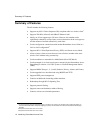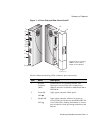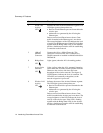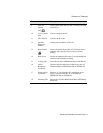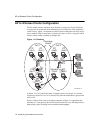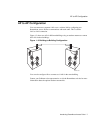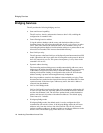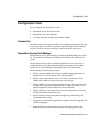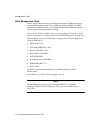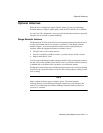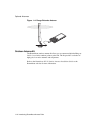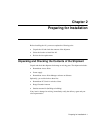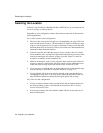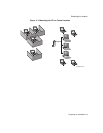
Bridging Services
1-8 Introducing RoamAbout Access Point
Bridging Services
The AP provides the following bridging services:
• Store-and-forward capability
The AP receives, checks, and transmits frames to other LANs, enabling the
configuration of extended LANs.
• Frame filtering based on address
Using the address database and the source and destination addresses from
incoming frames, the AP isolates the traffic that should not be allowed on other
LANs. This action reduces the total data traffic on an extended LAN by not
forwarding the packets that have local destination addresses or packets that are not
allowed to be forwarded. This increases bandwidth efficiency.
• Data Link layer relay
The AP operates at the Data Link layer of the Open System Interconnection (OSI)
model. Operation at this layer makes the AP transparent to the protocols that use
the LAN connectivity service. This protocol transparency is a key factor in the
extended LAN service.
• Dynamic address learning
The forwarding and translating process module automatically adds new source
addresses to the address database while the AP is operating. This reverse learning
of the address and port association allows automatic network configuration
without prior downline loading of configuration data to the AP. Note that the
address learning is protocol and management entity independent.
How long an address remains in the database is determined by an Aging Timer
that measures how much time has elapsed since data was last addressed to or from
a particular node. If the timer lapses without any traffic, the node’s address is
removed from the database.
• LAN-to-LAN Bridge mode
LAN-to-LAN mode is used to configure the AP to communicate with another AP.
In LAN-to-LAN mode, the AP learns addresses from both the wireless network
and the wired Ethernet LAN. The AP filters packets based on their destination
address and forwards all packets with unknown addresses. The default Aging
Timer interval is 2 minutes.
• Workgroup Bridge mode
Workgroup Bridge mode (the default mode) is used to configure the AP to
communicate with wireless clients. In Workgroup Bridge mode, the AP learns
addresses only from the wireless side of the network. The AP only forwards
packets to multicast addresses, broadcast addresses, and known addresses on the
wireless LAN. The default Aging Timer interval is 32 minutes.





